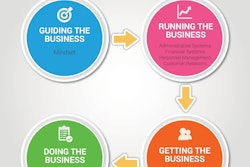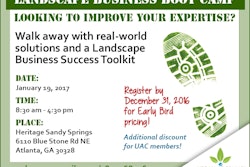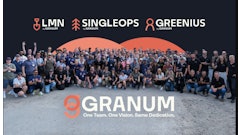
All landscape companies go through different phases, each of which present a set of challenges that must be met in order to advance to the next phase. According to Steven Cohen, a landscape/snow industry veteran and principal of GreenMark Consulting Group, these challenges are fairly predictable. Thus, a company can continue to thrive in the face of these obstacles—if the owner and leadership team are well-prepared.
Three primary phases exist: Performance, Profit and Renewal. In this first of two articles, Cohen will walk us through the Performance Phase. He'll talk about the Profit and Renewal Phases next issue.
Stage 1 – Dream2Plan (first few years in business)
The Performance Phase is when the company is primarily focused on acquiring clients, delivering services and generating cash flow. With all of the hustling and bustling that's going on, it's important for the owner to slow down long enough to make sure a few things happen.
First, create a business plan. This includes developing a written mission statement, along with near- and long-term goals with respect to sales, employees, customer base, etc. Owners also need to come up with a financial plan (i.e. budget), marketing plan and organizational chart.
Second, develop the brand. Drawing from what has already been developed for the business plan, the owner should identify the products and services being offered, along with the space in the market the company wants to target, i.e. high-end residential, high-end commercial, etc. Research must be done in order to identify the needs of those target markets. Then owners can outline how their company and its services appeal to those needs. A logo and overall brand image should also be developed that appeals to the target market(s).
Third, owners want to start mapping out key operating systems and processes. At this point, it is best to focus on an accounting system that will continue working as your company grows. Seek the help of a professional in this area.
"One of the most important decisions you will ever make for your business is choosing an accounting software solution that best fits your business model," Cohen says. "At this stage of the business, we suggest using accounting software such as QuickBooks online for the simple recording of business transactions including revenue, expenses and profitability."
Stage 2 – GoLive (sales up to $350,000)
The company has been operating for a while now—maybe one to three years—and the dream is turning into reality. Opportunities arise, jobs are accepted and completed, and cash is generated. The owner is the primary, if not only, salesperson. The owner is also helping to complete a lot of the work. The stresses can be tremendous, but the focus must remain largely on sales.
"Customers must be convinced to trust this new business—and that usually means a direct relationship with the owner," Cohen points out. "One thing owners should do is invest in a good CRM (customer relationship management) software package. This helps maintain consistency and attention to detail throughout the entire sales process. Finally, it's tremendously helpful if the CRM software can be integrated with your accounting software."
Having a single software solution that integrates accounting with CRM data will greatly improve the communication and productivity of your company—especially as it grows. "The sales team, marketing team and the accounting department can quickly know the state of their accounts and their accounting," Cohen explains. "By maintaining important business data in one location, you will observe a reduction in redundant and miscalculated data, and you will be able to download and analyze data quicker and easier. The number one 'gap' I have found in our client companies is the lack of historical data relating to the customer interface."
The CRM acts as a collection point for important business data relating to the customer interaction process. It also provides useful dashboards of information relating to all facets of the customer interface, including your sales pipeline activity. Examples of CRM benefits and important "extractable" information include:
- Customer interactions and information (in the form of letters, forms, documents, emails, etc.) stored in one convenient location and accessible to everyone in the company
- Helps ensure that all leads in the sales pipeline are being followed up on
- Helps coordinate specific marketing campaigns and follow-up activities relating to the sales cycle
- Generates accurate information on forecasts/pipeline activity
- Allows you to view all sales activity and results in a timely manner
- Allows you to see where you are strong in sales and where you are weak in sales
- Tell you if your sales team is producing.
Stage 3 – The Next Act (sales $350k to $1 million)
Things are starting to really click now. Referrals and the little bit of marketing being done are driving all kinds of new business the company's way. The company is well-known in the area and has a good reputation.
The urge to gobble up everything in its path and grow, grow, grow is insatiable. As a result, the owner is still primarily focused on sales. Virtually every opportunity is pursued, including client requests to diversify into new services. Little thought is given to whether or not the new service can be delivered adequately or is even in the company's long-term best interest. It's just that the owner never wants to say "no".
The problem is that with so much focus on saying "yes", a lot of little fires pop up here and there. Most are from operational mishaps, which distracts the owner and perpetuates a culture of reactive management, i.e. chasing and fixing problems.
Now it is critical for the company owner to starting building a team of middle managers to oversee daily operations. This will help insulate the owner from those daily mishaps, allowing him/her to remain focused on building the business.
Speaking of daily mishaps, the development of key operating systems becomes imperative now. This helps the company shift from a mode of "owner's direct supervision" to "standard procedures based on best practices". Everybody knows what to do and how to do it because the best possible way has been set in stone (i.e. written on paper as company policy). These best practices allow the company to deliver better service at a lower cost with fewer defects.
It's also imperative to add another component to your accounting system. "Activity-based costing is essential now," Cohen says. "You need to capture the true costs of delivering services, selling and account management, and so on. This process determines true profitability because if you don't know what it is really costing you to do things, you won't know how much to charge."
Stage 4 – Big Fast ($1 million+ in sales)
The business now has the look and feel of a real company. You have a dozen or so employees, and dozens and dozens of customers. The company is now running itself in an efficient and effective manner. The company has value.
"Opportunistic behavior is now being replaced with planned opportunism," Cohen points out. In other words, the opportunities you pursue aren't the ones that fall in your lap anymore. You pursue opportunities based on a well thought-out plan and strategy. "Some of the owner's entrepreneurial drive begins to get reigned in," Cohen adds. "Additionally, controls are put in place around behaviors and workflows that aren't well-accepted. There is much more focus."
Up until now, the key part of the company has been the owner (driving sales) and eventually a manager(s) helping to direct operations. Now, administrative support and human resources are critical elements. Hopefully, back during Stage 3, a strong accounting and information system was put in place. Likewise, best practice-based systems and processes should also have been put in place, allowing the company to run itself in an efficient and effective manner.
"The owner and management can now focus on results, allowing for employee decision-making and the best use of individual talent," Cohen explains. "Management can also focus on critical initiatives that will help to drive further growth, making sure that these initiatives are managed properly and fully funded. This includes a process to handle the rapid expansion of employees to support growth."




















